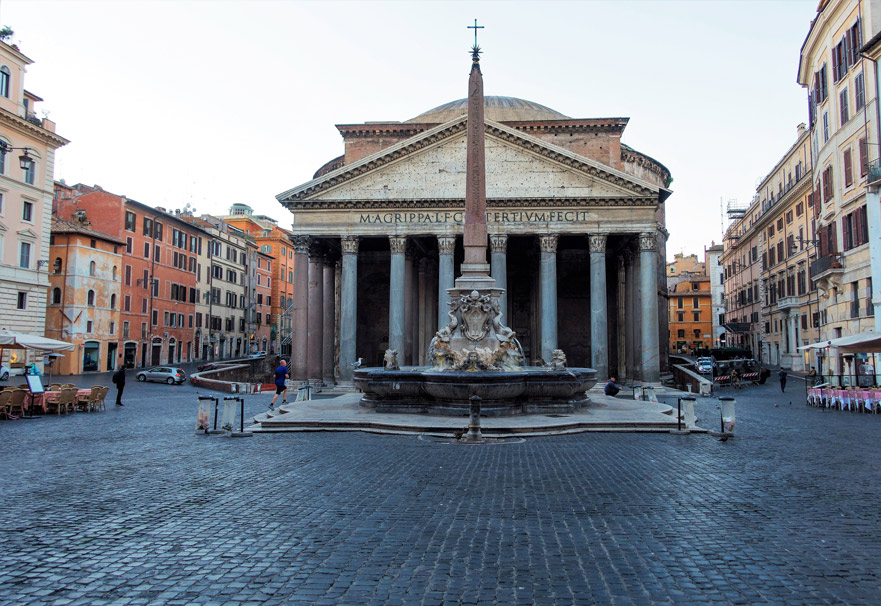Piazza della Rotonda – the tribulation of popes, a square cleaned for centuries

It was also the Pantheon, or more appropriately its form similar to a rotunda that provided the name for this location, which has accompanied it since the Middle Ages. Thanks to the fact that, as early as the beginning of the VII century the Temple of All Gods (Pantheon) was transformed into a church dedicated to Our Lady and Martyrs – Santa Maria ad Martyres (informally known as the Church of Santa Maria della Rotonda) it was not destroyed and taken apart, as was the case with other Roman structures, while the square in front of it served as a marketplace, where in the following centuries vegetables and fish were sold. In the morning full of the hustle and bustle of merchants and hurriedly put up stalls, later filled with rubbish and leftovers, stench and rats marauding around in the dirt. The Romans could not be convinced to change the location of the marketplace, stubbornly they traded in front of the church, even annexing the portico of the Marian church. Decisive steps were finally undertaken by Pope Eugene IV in the middle of the XV century. Desiring to change the character of the square to a more representative one and worthy of a Catholic church, he arranged it, paved it with travertine, while in the central point a porphyry bowl appeared. Nevertheless, a ban on trade introduced in this place did little to change proceedings as the stubborn Romans refused to change their habits. In the following century, this time during the pontificate of Pope Gregory XIII subsequent steps were undertaken with the aim to ennoble the square. For this occasion a fountain was created, designed by Giacomo dell Porta, whose bowl with protruding walls was enriched by mascarons (1575). Unfortunately, despite repeated papal edicts a lot of water had to flow through the fountain, referred to as Fontana della Rotonda, due to its location, before merchants were finally removed from this location. Once again the square was arranged by Pope Alexander VII in 1662, which was connected with the tearing down of the houses and small workshops located there. At the beginning of the XVIII century change was once again in the air and the fountain was enriched with an ancient Egyptian obelisk (Macuteo Obelisk).

Despite all these attempts, the travelers describing the square at the beginning of the XIX century do not paint a very favorable picture. At that time not only fish were traded, but also exotic birds – parrots, canaries and nightingales. The Englishwoman, Charlotte Anne Eaton, who stayed in Rome in the year 1820, writing about the square complained about the horrible stench prevalent throughout, puddles and dirty surface, as well as noise and bothersome beggars. It was not until 1847 that all of this had changed. The square was cleaned up and covered with characteristic for Rome dark, basalt pavement known as sampietrini, which we will encounter everywhere in the city, patiently chugging along its bumpy surfaces in buses and cars, not to mention bicycles. For some time the square was reminiscent of an elegant salon, when Italian emigrants from Buenos Aires funded a new surface for it, in 1906 made of a wooden parquet from the Argentinian forests, which completely muted the noise of the passing carriages and the sound of horse hooves. Reportedly, as it was claimed to not disturb the peace of the Italian kings and as the plaque on one of the tenement houses informs us, in order for the tombs venerated in the Pantheon to be surrounded by a “mercifully religious silence”.
At the square one of the first hotels in the city – the Locanda del Montone was built. It is first mentioned in 1467. Still today it attracts visitors with is unique atmosphere, but under a different name – Hotel del Sole. It hosted numerous outstanding guests, including the poet, author of The Frenzy of Orlando, Ludovico Ariosto, or the composer and creator of the famous opera Cavalleria Rusticana, Pietro Mascagni, of which we are informed by plaques found on its walls. There was also no shortage of extravagant guests, including Duke Alessandro di Cagliostro, one of the most colorful figures of XVIII century Europe – a free mason, occultist and swindler in one, who was arrested in this hotel and deported from Rome and when he once again returned he was captured and thrown into prison.
On the opposite side of the square, on the wall of one of the buildings, there is one of the most beautiful Roman Madonnelles. The fresco depicting the Madonna of Immaculate Conception, decorated with rich cartouches, was created in this place in the XVIII century. However, this is not what attracts Romans and tourists in the evening hours. The square full of bars and restaurants tempts with its unmatched atmosphere of a salon under the open skies, accessible to anyone who is willing to sit down or stop by for a moment to enjoy its aura. It is only empty at early dawn, but even then chairs and tables await incoming guests.
Może zainteresuje Cię również
Fontana della Rotonda – a work of papal ambitions and persistence
Zgodnie z art. 13 ust. 1 i ust. 2 rozporządzenia Parlamentu Europejskiego i Rady (UE) 2016/679 z 27 kwietnia 2016 r. w sprawie ochrony osób fizycznych w związku z przetwarzaniem danych osobowych i w sprawie swobodnego przepływu takich danych oraz uchylenia dyrektywy 95/46/WE (RODO), informujemy, że Administratorem Pani/Pana danych osobowych jest firma: Econ-sk GmbH, Billbrookdeich 103, 22113 Hamburg, Niemcy
Przetwarzanie Pani/Pana danych osobowych będzie się odbywać na podstawie art. 6 RODO i w celu marketingowym Administrator powołuje się na prawnie uzasadniony interes, którym jest zbieranie danych statystycznych i analizowanie ruchu na stronie internetowej. Podanie danych osobowych na stronie internetowej http://roma-nonpertutti.com/ jest dobrowolne.